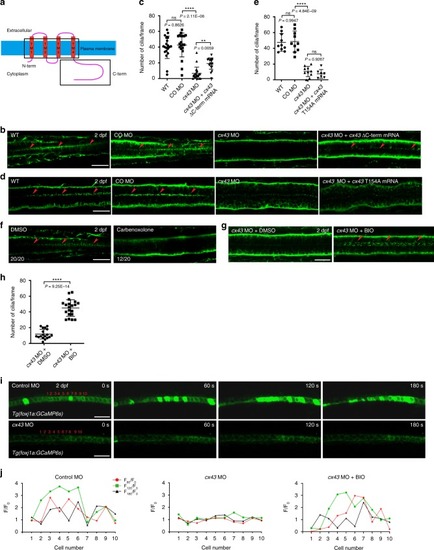|
The electrochemical coupling function of Cx43 plays an important role in the maintenance of ependymal motile cilia.a Domain structure of Cx43. TM, transmembrane. b, d Embryos at one-cell stage were microinjected with control MO, cx43 MO or cx43 MO + mRNA encoding mouse Cx43 lacking the C-terminal domain (b) or cx43 MO + mRNA that encodes mouse mutant Cx43 lacking the channel function (d), and IF stained with anti-acetylated α-tubulin antibody at 2 dpf. Arrowheads represent motile cilia. Dorsal view anterior to the left. Scale bar = 20 μm. c, e Quantification of the number of ependymal motile cilia in b, d, respectively. Mean ± SD. **P < 0.01 and ****P < 0.0001 by one-way ANOVA with Tukey’s HSD post hoc test: cn = 20 embryos per each group; en = 10 embryos per each group except cx43 MO + cx43 T154A mRNA (n = 7 embryos). ns, not significant. f Embryos were treated with carbenoxolone (1 μM) at 18–48 hpf and immunostained with anti-acetylated α-tubulin antibody at 2 dpf. Arrowheads point to motile cilia. Dorsal view anterior to the left. Scale bar = 20 μm. g Embryos at one-cell stage were microinjected with cx43 MO, treated with either DMSO (vehicle control) or BIO (5 μM) at 12–48 hpf, and IF stained with anti-acetylated α-tubulin antibody at 2 dpf. Arrowheads represent motile cilia. Dorsal view anterior to the left. Scale bar = 20 μm. h Quantification of the number of ependymal motile cilia per frame in embryos in g. Mean ± SD. ****P < 0.0001 by two-tailed unpaired Student’s t test (cx43 MO + DMSO: n = 18 embryos; cx43 MO + BIO: n = 20 embryos; one frame per embryo). iTg(foxj1a:GCaMP6s) embryos expressing a calcium indicator (GCaMP6s) in ECs were microinjected at one-cell stage with control MO or cx43 MO, and cx43 morphants were treated with BIO (5 μM) at 12–48 hpf. Subsequently, they were subjected to time-lapse imaging for 3 min (20 frames/min) with a confocal microscope. Dorsal view anterior to the left. Scale bar = 20 μm. j The GFP fluorescence intensity in ten cells (1–10) in each embryo in i was individually assessed at 0 (F0), 60 (F60), 120 (F120) and 180 s (F180), and presented as F60/F0, F120/F0 and F180/F0.
|

